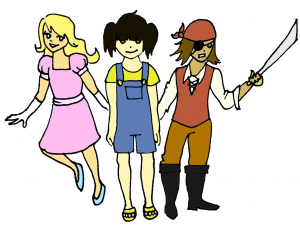Beyond Child’s Play: The Implications of Gendered Toys
We have probably all heard, time and time again, that the image of Barbie, with her impossible proportions, iconic blonde hair and numerous fashion accoutrements, is harmful to the female youth of America. But if today’s young girls are anything like my friends and I were when we were kids, they don’t let such stereotypically feminine toys dominate their childhoods. Stuffed animals, LEGOS, puzzles and games, Playmobile sets, and outside games are all wholesome, androgynous and, most importantly, fun alternatives to dolls, kitchen sets, or any other product marketed exclusively to girls. Granted, some young girls may stick exclusively to pink and purple, princess and doll playtime, and that is perfectly all right. The problem arises when toy companies promote gender binary divisions through marketing; the implication is that both genders must conform to what is expected of their sex. Such absolute divisions are not realistic and are damagingly absolute. An example of such a binary toy marketing campaign can be found in the release of the new LEGO Friends toys.
There are five of these perky, pretty dolls: Olivia, Stephanie, Mia, Emma, and Andrea. They come with range of hair colors and hobbies, but each has slender proportions, long hair and a variation on a tank top and mini skirt combination. To be fair, LEGO has shown some awareness of the diversity of the modern girl’s interests; there are mentions of sports, being environmentally conscious, fondness for animals, and building things among the characters’ favorite activities. But what is wrong with the old LEGO figures? They are all uniformly squat and chunky, with perhaps only a hairstyle to distinguish a female character; but they are fun and diverse and allow for infinite possibilities in play. LEGO’s creation of the Friends line indicates that toy companies abide by a rigid idea of what will be attractive to girls. This idea, apparently, cannot exist without lots of pink and purple and the inclusion of makeovers, fashion, and parties (other interests of the Friends characters).
There is the possibility that regardless of how the toy companies envision the passions and lives of little girls, girls will do what they like, even if what they like involves Tonka trucks and mud. This carefree attitude may apply to many girls, but what about those who, for one reason or another, internalize these corporate conceptions of what a girl ought to be like? The influence of advertising from these toy companies, as well as possible reinforcement of the gender norms from peers, could result in a girl spurning what she really wants to do, deeming it boyish and unfeminine. Such a state-of-mind is tragic, both for the confinement and limitation that it imposes upon a child and for the reflection it offers about society’s still inflexible view of femininity.
Furthermore, such overt marketing of toys to females harms limits the freedom of toy choice for little boys. In recognizing that the traditionally represented interests and characteristics of little girls are neither accurate nor realistic, it cannot be overlooked that the same is true for many boys. It is a sad reality that the stigma and ostracism attached to crossing traditional gender barriers for boys is often severe. In a perfect world, gender norms would be fluid and it would be perfectly acceptable for anyone to play with anything. Toys would not contribute to a perpetuation of a false binary. But the reality is that by producing a doll that is explicitly directed to female consumers, the social acceptability of a boy’s interest in the product is decreased.
Fortunately, the awareness of such narrow and gender-specific marketing of toys is receiving increasing recognition as a problem. Bailey Shoemaker Richards and Stephanie Cole, two activists, have started a petition rallying against the release of the LEGO Friends and demanding a more gender equitable marketing approach.[1] Alternatives to companies with binary gender norms can be found in the innovative Princess Free Zone and Pigtail Pals, which offer only androgynous toys and products to youngsters.[2] Recently, a video of a little girl ranting about rigid gender norms in a toy store has been circulating throughout the Internet. Four-year-old Riley Maida succinctly sums up the problem: “Some girls like superheroes, some girls like princesses, some boys like superheroes, some boys like princesses. So why do all the girls have to buy pink stuff and all the boys have to buy different color stuff?”[3]
Such awareness suggests that there is hope for more gender equity in toy marketing and, as a result, less rigid gender norms in the overall consciousness of our society. To combat the existing black-and-white gender conceptions and the toy companies that uphold them, the current population of children should be liberated by freedom of choice and encouraged to form a conception of gender that transcends the confines of pink and blue, Barbies and Star Wars, and dolls and cars.
[1] Candidates, Presidential. “LEGO Friends Petition: Parents, Women And Girls Ask Toy Companies To Stop Gender-Based Marketing.” Breaking News and Opinion on The Huffington Post. Web. 17 Feb. 2012. <http://www.huffingtonpost.com/2012/01/15/lego-friends-girls-gender-toy-marketing_n_1206293.html>.
[2] Candidates, Presidential. “LEGO Friends Petition: Parents, Women And Girls Ask Toy Companies To Stop Gender-Based Marketing.” Breaking News and Opinion on The Huffington Post. Web. 17 Feb. 2012. <http://www.huffingtonpost.com/2012/01/15/lego-friends-girls-gender-toy-marketing_n_1206293.html>.
[3] “Pink Stuff: Little Girl In Toy Store Rails Against Gender Stereotypes (VIDEO).” Breaking News and Opinion on The Huffington Post. Web. 17 Feb. 2012. <http://www.huffingtonpost.com/2011/12/24/pink-stuff-little-girl_n_1169044.html>.

![[in]Visible Magazine](https://community.scrippscollege.edu/invisible/wp-content/uploads/sites/5/2011/04/Invisible-Masthead-2011-Spring1.png)








No comments yet... Be the first to leave a reply!